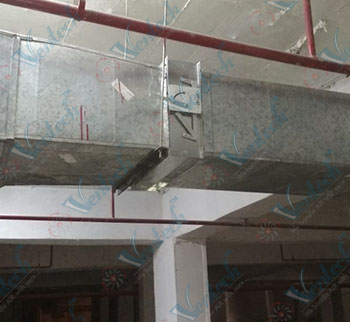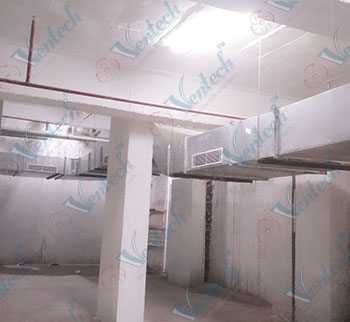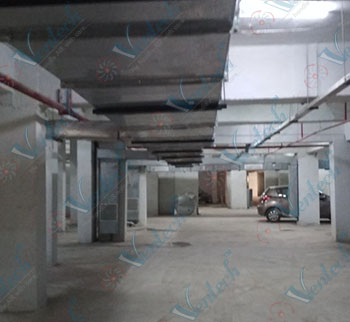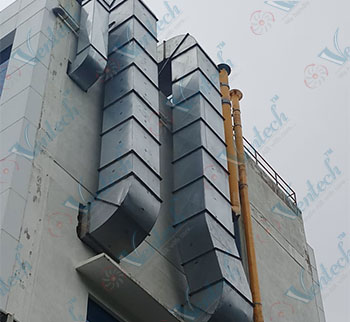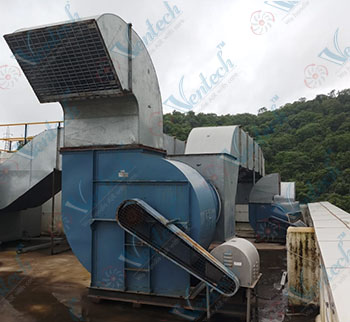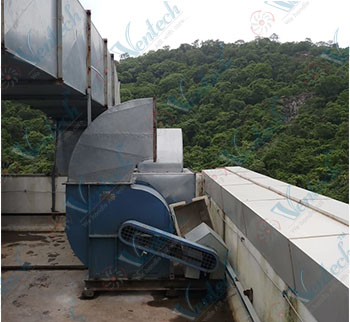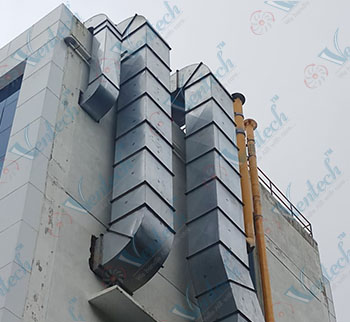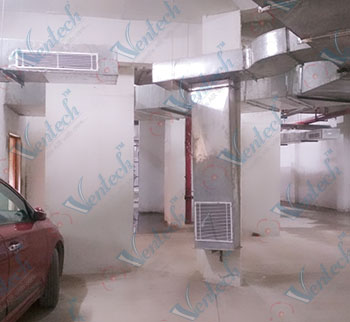VENTILATION is basically dilution of the occupied space by fresh outside air. A ventilation system involves in sweeping a particular space with relatively large quantities of air. This way, an improved environment can be achieved by controlling to some extent several parameters such as air motion, air purity and sometimes, air temperature.
- The term ‘Ventilation, as understood in Industries, generally covers the following :
- A) General Ventilation
- B) Controlling heat in Industrial Work Zones
- C) Industrial Exhaust Systems or Local Exhaust Ventilation
- A) GENERAL VENTILATION
- All working zones should have general ventilation for any one of the following reasons :
- 1) To supply fresh air for breathing,
- 2) To dilute the inside air with fresh outside air, this reduces the vitiation of the environment by body odours and also certain contaminants which may be given off during certain manufacturing operations
- 3) To provide heat balance for the body.
The supply of fresh air for breathing rarely calls for any special attention. Air entering the shop area by infiltration is usually more than sufficient to provide sufficient oxygen for the body. As regards the contamination of the environment by body odours, etc. this mostly depends upon the air space available for worker, and also the amount of physical activity. Generally, ventilation at the rate of 3 air changes per hour and above greatly minimizes vitiation of occupied space by body odours. Here, the air movement is also of vital importance. By air changes, it is meant , the volume of outside air allowed in the work zone compared with its own volume.
General Ventilation is also necessary to maintain heat balance of the body. This is especially so in hot locations more so when the conditions in the working area are worsened by heat given off from the manufacturing machinery. The normal body temperature should always be maintained at 37 deg.C., regardless of the physical activity of hot environment. Increased supply of fresh air into the working area will greatly relieve the heat loads . The heat dissipation from the body to its surroundings will depend upon the ambient dry bulb temperature , relative humidity and the radiated heat from the surrounding and also air movement.
In hot dry locations, one may with advantage cool the outside air before it is supplied into the working area. In shops, where the relative humidity is high but the air temperature is below the body temperature , air movement will greatly reduce the heat stress by dissipating the heat from the body. This is achieved by evaporation of sweat. Generally, the relation between the dry bulb temperature and the corresponding wet bulb temperature in the working area should not , as for as practicable, exceed the figure given below :-
| Dry Bulb Temperature(deg.C) | Maximum Wet Bulb Temperature(deg.C) |
|---|---|
| 30 deg. C | 29 deg. C |
| 35 deg. C | 28.5 deg. C |
| 40 deg. C | 28.0 deg. C |
| 45 deg. C | 27.5 deg. C |
Generally , the efficiency decreases with the rise in the DBT . Therefore, efforts should be made to bring down the DBT as well when the ambient exceeds 45 deg. C. As regards designing the Ventilation plant, a good ventilation system viz. Fresh air supply and exhaust system is tailor – made , each particular department will be best served by a specifically designed Ventilation System. However, one common right method of designing the system is to opt for Air CHANGE basis . For the sake of academic interest , furnishing below some of the typical air change rates that are followed :-
| Sr. No. | Area | No. of ACPH |
|---|---|---|
| 1. | Auditoriums | 7 |
| 2. | Boiler House | 50 |
| 3. | Cafetaria | 10 |
| 4. | Foundries | 50 |
| 5. | Domestic Kitchens | 25 |
| 6. | Offices | 10 |
| 7. | Dark Rooms | 25 |
| 8. | Machine Shops | 12 |
| 9. | Lavatories | 12 |
| 10. | Laundries | 12 |
| 11. | Paint Shops | 40 |
| 12. | Theatres | 20 |
Of course, where there is heat or steam involved , one has to provide for higher rate of air changes. Also, where there is occurrence of smoke and also in areas where the ambient conditions are always hot, here again, the number of air changes have to be increased.
Another thumb rule criterion for providing Ventilation is to provide ventilation on the basis of certain quantity of fresh air unit floor area. This figure also fails to take into consideration the actual heat relief that the system has to provide . However, it does give a relationship which is independent of the building height. This is a more rational approach. This way, with the same internal load, the ventilation air when properly applied to the lower work zones will certainly provide a comparatively better heat relief. On the other hand, if one goes on the basis of air changes rates, there is every possibility that high air changes may be provided at the upper levels of the building with no proper relief being provided at the lower work zones, where ventilation is actually required. In fact, such ventilation may even entrain hot ceiling air, thereby creating a far worse working condition.
Furnishing below some of the typical figures recommended by ASHRAE :-
Ventilation of Locker Rooms, Toilets & Shower Spaces
| Sr. No. | Area | Velocity |
|---|---|---|
| 1. | Locker Rooms | 0.05 m /sec. |
| 2. | Change Room for labouring employees with wet or sweaty clothes | 0.1 m/sec or 0.4 m/sec exhausted from each locker |
| 3. | Change room for heavy labourers or workers assigned to working and cleaning where clothes will be wet or pick up heavy odours | 0.2 m/sec. or 0.6 m/sec. exhausted from each locker |
| 4. | Toilet Space | 0.1 m/sec. |
| 5. | Shower Space | 0.1 m/sec. |
There is also another standard , whereby ventilation is provided on the basis of occupany. As per this method, the capacity of Ventilation plants are determined at the rate of 1000 cfm per person.
A more rational approach of determining the quantitiy of ventilation air will be to use the following formula :-
Q= 0.0577 X Ks / t
Where Q = quantity of air in cu.m./min.
Ks = sensible heat gained in Kcal / Hour
T = temperature rise allowable in deg. C
This formula takes into consideration the various heat gains in the occupied space viz. heat radiation in the sun, heat dissipated by the different operations, as also heat arising out of occupancy. Here , one should pre-determine the temperature rise in the working area which would be acceptable.
Alternatively, if latent heat gain from moisture given off by processes and occupants is also known , and acceptable rise in vapour pressure is determined in advance , then ,
Q= 80 X Kl / t
Where Q = quantity of air in cu.m./min.
Kl = latent heat gained in Kcal / Hour
T = vapour pressuredifference allowable in mm of mercury
Generally, it is better to give some safety margin to the air quantity thus obtained by the above formulae.
Mechanical Ventilation Systems are broadly classified into three systems :-
- 1) Mechanical Supply and Natural Exhaust Systems
- 2) Natural Supply and Mechanical Exhaust Systems
- 3) Mechanical Supply and Mechanical Exhaust Systems
Mechanical Supply Systems
In mechanical supply air system, the greatest advantage is that the supply air can be filtered. If necessary, one can have an Evaporative Air Cooling System also. The Evaporative AIR Cooling System reduces the dry bulb temperature and provides a better environment for the working area. The air that is supplied to the area is passed through atomized water. The sensible heat of the air is reduced proportionally to the amount of evaporation that takes place. The maximum possible dry bulb temperature reduction is the difference between the entry air dry bulb and wet bulb temperatures. Naturally, the effectiveness of this system will be more where the ambient conditions are dry, as in the interior locations such as places like Nagpur, etc. Especially, these evaporative cooled fresh air systems are of great advantage in improving the environment of the worker in hot operations , such as steel mills, foundries, power houses, etc.
Another advantage of Evaporative Air Cooling System is that fresh air can be blown in places where they are required most. The term what is known as ‘spot cooling’ or more correctly ‘ spot ventilation’ is very popular in some of our mechanical supply ventilation systems installed in hot working zones, such as tyre working factories, etc.
Mechanical Extraction Systems
This system is a must in areas where there is excessive heat or smoke. In such areas, mechanical exhaust system not only reduces the dilution of the contamination inside, but also there will be a certain amount of underpressure, which will result inside the department. This way, it is the air from the surrounding areas which will come into the department. In other words, the tendency for the heat and smoke of this department to spread out to the adjoining areas is greatly minimised. One can appreciate such a system especially when the heat or smoke producing department is surrounded by other departments, such as machine shops,etc.
Mechanical Supply and Mechanical Exhaust Systems
As can be envisaged , there is a full control of ventilation if combination of supply and exhaust systems are adopted. If, of course, a department is hot or smoky, the quantity of supply air should be less than what is exhausted . On the other hand, if greater air purity is required , the quantity of supply air should be more. Of course, in this case, the supply air must be filtered.

